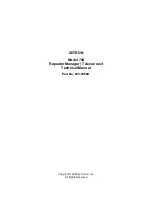
– 60 –
24. Monitor for excessive heat or vibration during
operation.
25. All bearings are pre-lubricated and should not
require greasing. Refer to the bearing manufacturer’s
instructions or the unit manufacturer’s instructions
for proper bearing maintenance.
Note: Drive side Sleevlock bearing installation
(SPB-2115-C2).
1. Mount all the bearings and leave all the bolts and
setscrews loose
2. Tighten setscrews on Sleevlock bearing to
the tightening pattern as described in the
installation sheet that comes with the bearing
to a fi nal 65 inch lbs while rotating the shaft.
Check to make sure the insert of the bearing is
centered in the bearing housing and then bolt
bearing down.
3. Tighten down the bolts and setscrews on
the remaining bearings per installation sheet
starting from the end bearing back toward’s the
Sleevlock while rotating the shaft.
3. Dampers – Dampers should be inspected monthly
(daily in icy weather)
for securely fastened linkages,
and smooth operation. If dampers are binding or
excessively noisy, then lubrication may be required.
Place one drop of #20 wt. machine oil, silicone spray,
graphite or equal on each blade bearing, and linkage
ball joint. Do not over lubricate, and wipe any excess
from the area. Be sure to note that dampers over 49
inches long have intermediate bearings which require
lubrication.
3. Louvers – Louvers should be inspected monthly
(daily in icy weather)
to insure they are clean and
clear.
C. Air Filters
All fi lter banks should be equipped with a manometer
or differential pressure switch to indicate when the
fi lters are dirty. Filters should be replaced when
the differential pressure across them reaches the
manufacturer’s recommended fi nal value. Dirty fi lter
elements should be replaced with a clean element
of the same type and size. In addition, the factory
not only suggests, but insists, that air fi lters be
checked every 30 days (daily in icy weather)
and
replaced with new fi lters (throw-away type) or cleaned
(washable type) as required. Cleanable fi lters should
be given new application of fi lter coating after washing
to maintain optimum fi lter performance.
The frequency of cleaning and replacing air fi lters
applies twelve months of the year,
where blowers
are used for ventilation and heating.
D. Belt Tensions and Adjustments
Belt tension is adjusted during the initial run-in and test
periods at the factory. However, the belts are run as
slack as possible to prevent excessive damage to the
bearings, yet tight enough to prevent slippage.
It is necessary, therefore, to tighten all belts during the
fi rst few months of operation, and to
check for proper
tension weekly during
the
fi rst 60 days,
after which
30-day check intervals are suffi cient.
WARNING: Turn off all power to the equipment
before checking belt tensions.
CAUTION: Do not attempt to tighten any belt or belts
by changing the pitch of an adjustable pulley, as this
will change the speed of a driven pulley, causing the
unit to be rendered OUT OF AIR BALANCE. Do not
overtighten belts.
Suggested Belt Tension Method is with the use of a
Belt Tension Checker
1. Check tension frequently during the fi rst 24-48
hours of run-in operation. Ideal tension is the lowest
tension at which the belt will not slip under peak
load conditions. Over tensioning shortens belt and
bearing life.
Alternate Belt Tension Method
2. To properly tension a conventional V-belt drive use
the following procedure:
a. Measure the span length.
b. At the center of the span, apply a force perpen-
dicular to the span to defl ect the belt 1/64 inch for
every inch of span length. For example, for a 40
inch span, apply a force that will defl ect the belt
40/64 or 5/8 of an inch.
c. Compare the force you have applied with the
values given in the table below. If the force is
between the values for normal tension and 1-1/2
times normal tension, the belt tension should be
satisfactory. If the belt tension is not within this
range, it can be adjusted by loosening the motor
mounting bolts, and adjusting the position of the
motor along its base.
B Section
small
Pounds
pulley
Pounds Force
for
diameter
Belt Force
for
1
1
/
2
times
range
in Manufacturer
Normal
Normal
Inches
&
Type
Belt
Tension Tension
3.4-4.2
Gates
Hi-Power
4.4
6.6
4.4-4.6
Gates
Hi-Power
4.9
7.4
5.8-8.6
Gates
Hi-Power
5.8
8.7
Note: For recommendation of other types of belts,
consult respective manufacturers.
E. Optional Coils And Related Items
1. Coils – Coil surfaces must be kept clean of dirt
and lint in order to operate at rated effi ciency. Coils
should be inspected on a regular basis and cleaned
as required.
Summary of Contents for GAS-FIRED HEATERS
Page 6: ... 6 ...
Page 7: ... 7 ...
Page 8: ... 8 ...
Page 9: ... 9 ...
Page 13: ... 13 ...
Page 24: ... 24 TYPICAL SEQUENCE FOR MODULATING THERMOSTAT WITH 135 OHM CONTROLS ...
Page 25: ... 25 TYPICAL SEQUENCE FOR MODULATING THERMOSTAT WITH 4 20 mA CONTROLS ...
Page 64: ...4830 Transport Drive Dallas TX 75247 Phone 214 638 6010 Fax 214 905 0806 www appliedair com ...





































